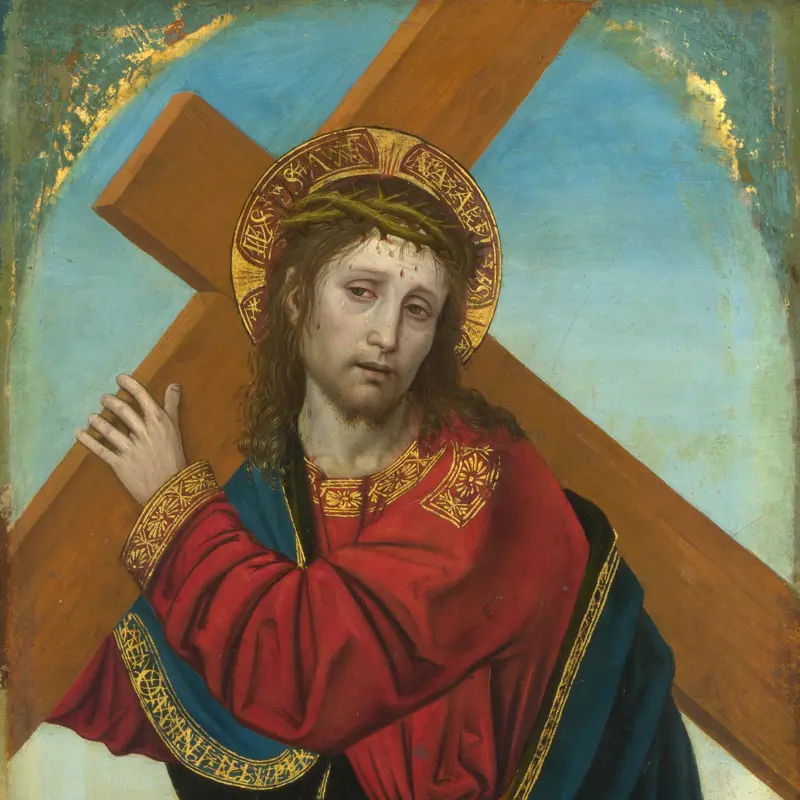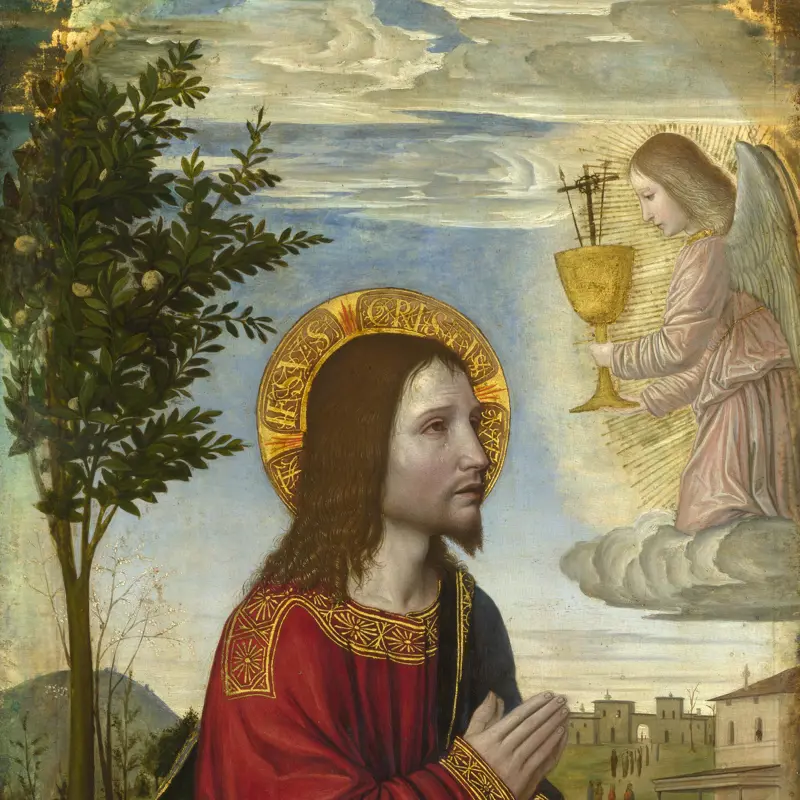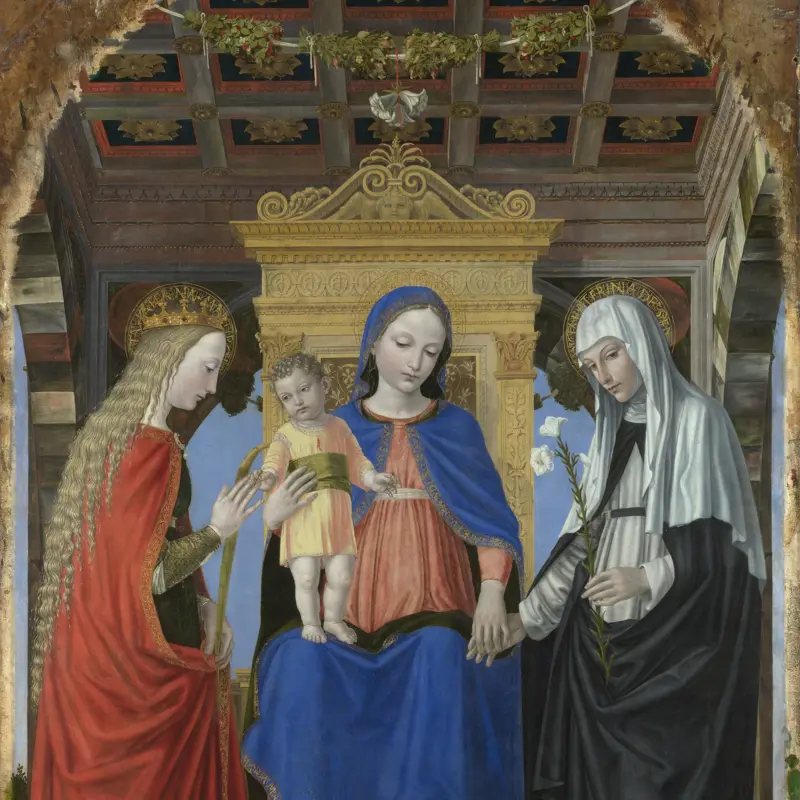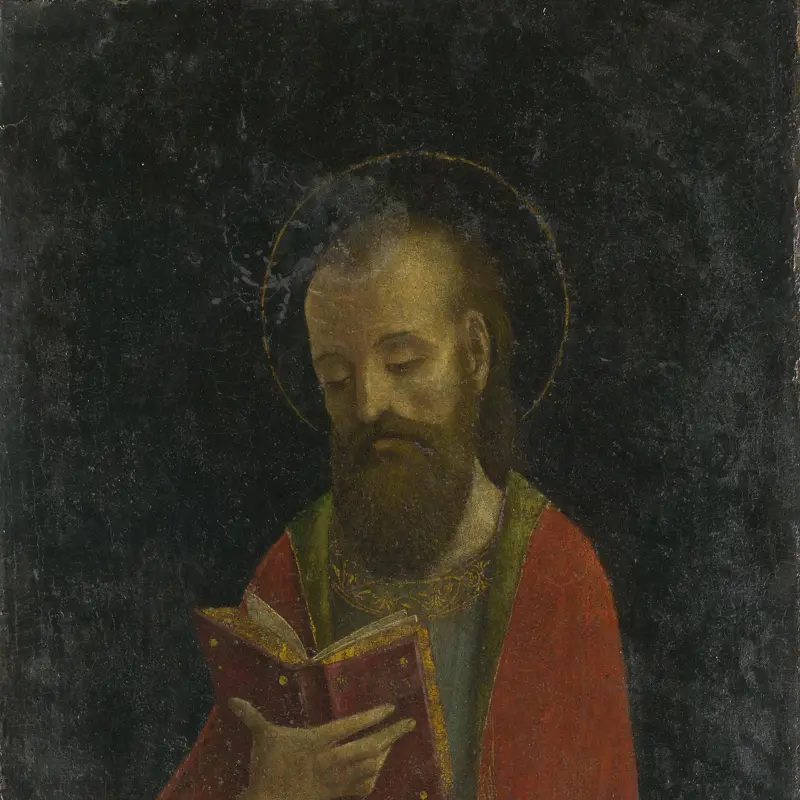Ambrogio Bergognone, 'The Virgin and Child', about 1488-90
About the work
Overview
The Virgin Mary stands behind a stone parapet, supporting her infant son with one hand; Christ balances on a green cloth lying over the sill. In the background you can see monks in white habits strolling in the grounds of a large church – one is accompanied by a layman and his dog.
The monks are Carthusians, and the church is the Certosa (Charterhouse) of Pavia, where Ambrogio Bergognone worked from the late 1480s. You can see the front of the building under construction to the right of the Virgin’s cloth of honour. This small panel may well have been made for the private devotional use of one of the monks.
Key facts
Details
- Full title
- The Virgin and Child
- Artist
- Ambrogio Bergognone
- Artist dates
- active 1481; died 1523?
- Date made
- about 1488-90
- Medium and support
- oil on wood
- Dimensions
- 55.2 × 35.6 cm
- Acquisition credit
- Bought, 1894
- Inventory number
- NG1410
- Location
- Room 14
- Collection
- Main Collection
- Previous owners
- Frame
- 20th-century Replica Frame
Provenance
Additional information
Text extracted from the ‘Provenance’ section of the catalogue entry in Martin Davies, ‘National Gallery Catalogues: The Earlier Italian Schools’, London 1986; for further information, see the full catalogue entry.
Exhibition history
-
2014Building the Picture: Architecture in Italian Renaissance PaintingThe National Gallery (London)30 April 2014 - 21 September 2014
Bibliography
-
1894Christie's, Catalogue of the Collection of Pictures Chiefly by Old Masters Formed by Sir C. L. Eastlake, London, 2 June 1894
-
1895L. Beltrami, Ambrogio da Fossano detto il Borgognone, Milan 1895
-
1895G. Frizzoni, 'La Galleria Nazionale di Londra e i suoi recenti acquisti in fatto d'arte italiana', Archivio storico dell'arte, 1895, pp. 87-105
-
1898H.F. Cook, Catalogue of Pictures by Masters of the Milanese and Allied Schools of Lombardy, London 1898
-
1900S. Brinton, Leonardo and His Followers, London 1900
-
1907B. Berenson, North Italian Painters of the Renaissance, New York 1907
-
1914G. Cagnola, 'Intorno al Bergognone', Rassegna d'arte, XIV, 1914, pp. 217-22
-
1922V. Costantini, La pittura Lombarda dal XIV al XVI secolo, Milan 1922
-
1925M. Salmi, La Certosa di Pavia, Milan 1925
-
1932B. Berenson, Italian Pictures of the Renaissance: A List of the Principal Artists and Their Works, with an Index of Places, Oxford 1932
-
1936B. Berenson, Pitture italiane del Rinascimento: Catalogo dei principali artisti e delle loro opere con un indice dei luoghi, Milan 1936
-
1945N. Aprà, Ambrogio da Fossano detto il Borgognone, Milan 1945
-
1947E.S. Vavalà, 'Ambrogio Borgognone in a Recent Publication', The Burlington Magazine, LXXXIX/536, 1947, pp. 305-9
-
1948F. Mazzini, Ambrogio da Fossano detto il Borgognone, Brescia 1948
-
1951Davies, Martin, National Gallery Catalogues: The Earlier Italian Schools, London 1951
-
1961M. Davies, The Earlier Italian Schools, 2nd edn, London 1961
-
1963J. Poracchia, Il Bergognone (Ambrogio da Fossano) 1455 c.-1523, Milan 1963
-
1963G. Borlini, 'The Façade of the Certosa in Pavia', Art Bulletin, XLV, 1963, pp. 323-36
-
1968B. Berenson, Italian Pictures of the Renaissance: A List of the Principal Artists and Their Works, with an Index of Places: Central Italian and North Italian Schools, revised edn, 3 vols, London 1968
-
1968F.R. Pesenti, 'La pittura', in C. Angelini et al., La Certosa di Pavia, Milan 1968
-
1969U. Bicchi, La Certosa di Pavia, Milan 1969
-
1973C. Pirovano, 'Temi della luce, verifica della realtà', in A. Caizzi (ed.), Lombardia, Milan 1973
-
1978C.R. Morscheck, Relief Sculpture for the Facade of the Certosa di Pavia, 1473-1499, New York 1978
-
1986Davies, Martin, National Gallery Catalogues: The Earlier Italian Schools, revised edn, London 1986
-
1998G.C. Sciolla, Ambrogio da Fossano detto il Borgognone (exh. cat. Castello Visconteo and Certosa di Pavia, 4 April- 30 June 1998), Milan 1998
-
2001
C. Baker and T. Henry, The National Gallery: Complete Illustrated Catalogue, London 2001
-
2001E. Bernini and R. Rota, Il Quattrocento, Rome 2001
About this record
If you know more about this work or have spotted an error, please contact us. Please note that exhibition histories are listed from 2009 onwards. Bibliographies may not be complete; more comprehensive information is available in the National Gallery Library.





